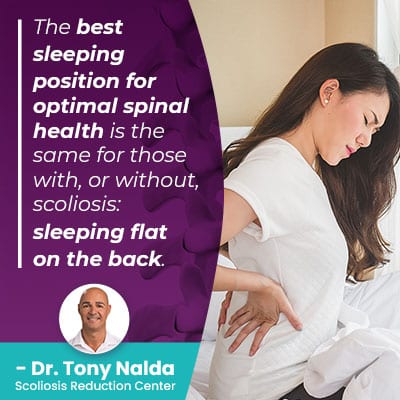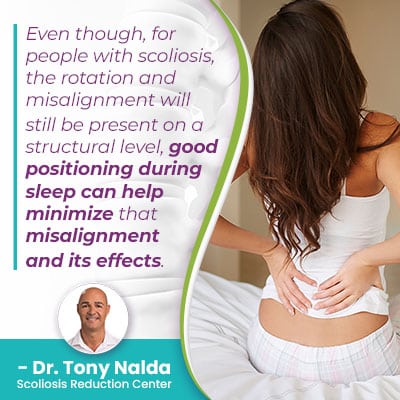How To Sleep With Scoliosis: Practical Tips For Better Sleep

Good sleep is important for everyone, but for those living with the extra challenge of a progressive spinal condition, it can be especially important, particularly when it comes to treatment efficacy. Sleep helps the body restore and rejuvenate, and a body that’s well-rested is one that’s going to be more responsive to treatment.
Each case of scoliosis is as unique as the patient themselves, so while one person may find it difficult to sleep with scoliosis, another might not. For those experiencing condition-related sleep problems, the best answer is proactive treatment and knowing the best sleeping position for scoliosis.
Before getting to the specifics of how to sleep with scoliosis, let’s take a minute to define the condition itself for a better understanding of how it can affect sleep.
What is Scoliosis?
Scoliosis is a structural spinal condition that involves the development of an unnatural sideways spinal curve, with rotation and a Cobb angle measurement of at least 10 degrees.
Scoliosis doesn’t just cause the spine to bend unnaturally to the side, but also twists from front to back, back to front (rotational component).
A patient’s Cobb angle is a measurement obtained during an X-ray that tells me how far out of alignment a scoliotic spine is, and 10 degrees is the diagnostic cutting point.
Scoliosis introduces a lot of uneven forces to the body, which is why the main symptom in children and adolescents is a postural deviation that involves a disruption to the body’s overall symmetry, and the main symptom in adults is back, or radicular pain felt throughout the body.
Scoliosis can make it hard to get comfortable at night, and for those who find their condition painful, the discomfort only adds another challenge to getting a good night’s sleep.
In addition, in severe cases, complications like lung impairment can make sleep even more challenging.
While most cases of condition-related lung impairment are only noticeable during periods of extreme physical exertion, it can also affect sleep.
Particularly with thoracic curves (middle/upper back), the ribs can be affected. As thoracic scoliosis develops, the unnatural spinal curve can pull on the rib cage, disrupting its position and causing the development of a rib arch.
Once a rib arch develops, depending on severity, it can impact the mechanics of respiratory muscles and cause a decrease in lung volume; breathing patterns are important to sleep, so if a patient is experiencing lung impairment, it can impact sleep by not being able to inhale or exhale deeply and rhythmically.
In my years of treating scoliosis and listening to my patients describe how it affects their daily life, in terms of sleep, scoliosis tends to mainly affect sleep in those two ways: pain making it difficult to get comfortable, and lung issues.
When it comes to lung impairment, the best remedy is to seek out proactive treatment that impacts the condition on a structural level, and when it comes to getting comfortable, we’re talking about finding the best sleep position for scoliosis.
How to Sleep with Scoliosis: Best Sleeping Position for Scoliosis
 The best sleeping position for optimal spinal health is the same for those with, or without, scoliosis: sleeping flat on the back.
The best sleeping position for optimal spinal health is the same for those with, or without, scoliosis: sleeping flat on the back.
In fact, the best way to sleep with most spinal conditions is flat on the back, with a cervical pillow.
Cervical pillows help support the neck properly while a person sleeps and can help keep the back as straight as possible.
The health of each spinal section’s curve depends upon the others, so if the spine is adequately supported at its uppermost level (neck), those effects are also felt in the lower sections (thoracic and lumbar): the benefit of a cervical pillow.
Sleeping on the back keeps the spine in a straight and neutral alignment with no one section bent or arched unnaturally, meaning no one section is more strained than the others.
In addition, sleeping on the back means the body’s weight is evenly distributed and absorbed by the spine and its surrounding muscles, so there is no extra stress or tension placed on the spine.
Sleeping flat on the back supports the spine’s natural and healthy curves at the cervical, thoracic, and lumbar sections.
When it comes to bad sleeping positions for scoliosis, we’re talking about those that strain the spine and increase discomfort.
Bad Sleeping Positions for Scoliosis
The worst sleeping position for scoliosis is the same as the worst sleeping position for anyone: stomach sleeping.
Stomach sleeping is the unhealthiest sleeping position because it doesn't properly support the spine or promote a healthy and neutral alignment.
When someone lies flat on their stomach, the back is unnaturally arched, putting strain on the upper back and neck by putting them in an unnatural position and introducing adverse spinal tension.
For people with scoliosis, their spines are already exposed to adverse spinal tension due to the uneven forces introduced by the unnatural spinal curve, so sleeping in a position that increases that stress will only increase related pain and discomfort and exacerbate symptoms.
Other Sleeping Positions for Scoliosis
After sleeping flat on the back, the next best sleep position for scoliosis is sleeping on the side with a cervical pillow; this is because if the cervical spine is adequately supported, it means the neck is in a neutral alignment with the torso, which then keeps the torso aligned with the pelvis.
Alignment is important because, with scoliosis, the spine becomes misaligned.
The vertebrae (bones of the spine) are stacked on top of one another in a straight and neutral alignment, but as scoliosis develops, certain vertebrae are tilted unnaturally, hence the unnatural sideways spinal curve.
Treatment efficacy is based on the ability to realign the spine by restoring as much of the spine’s healthy curves as possible, so we want to try and keep the spine aligned as much as possible during sleep because this is what’s ideal for spinal health and function.
 Even though, for people with scoliosis, the rotation and misalignment will still be present on a structural level, good positioning during sleep can help minimize that misalignment, and its effects.
Even though, for people with scoliosis, the rotation and misalignment will still be present on a structural level, good positioning during sleep can help minimize that misalignment, and its effects.
In addition, for side sleepers, adding a thin pillow between the knees can help ensure that the spine is optimally aligned and supported during sleep, and no one side, left or right, is better than the other. Whichever side is the most comfortable is the best side-sleeping position for those with scoliosis.
In addition, there are also customized scoliosis pillows that can help facilitate better sleep.
Customized Scoliosis Pillows
Something that many people are unaware of is the benefit of a properly-fitted and customized pillow.
An average pillow is a one-size-fits-all standard size, but when you think about it, a person who is 6 feet tall is going to find a certain size of pillow the most ideal, and it’s likely not going to be the same size pillow that someone who is 5-feet tall or less chooses.
The reason for getting a customized pillow is that it’s fitted to a person's body type, size, shoulders, and back, which affects pelvic positioning. When a pillow is customized to a certain body type, the upper spine and neck are adequately supported and aligned with the torso and the rest of the body, and this facilitates healthy spinal alignment and optimal sleep.
Conclusion
When it comes to how to sleep with scoliosis, we’re talking about positions that are known to be best for the spine and those that are the most comfortable.
Scoliosis can affect the body in a multitude of ways, sleep issues included.
From causing postural deviation and related muscle pain to structural back pain and/or radicular pain felt throughout the body, scoliosis can most certainly impact a person’s ability to get a good night’s sleep.
In addition, the spine works in tandem with the brain to form the body’s central nervous system (CNS), another reason spinal conditions can cause such widespread effects.
The best sleeping position for scoliosis is flat on the back. The next best is sleeping on the side, followed by stomach sleeping as the worst sleep position for scoliosis.
In addition, a customized scoliosis pillow can also help improve sleep, as can proactive treatment that impacts the condition’s underlying structural nature.
Here at the Scoliosis Reduction Center, I can help patients work towards better sleep through proactive treatment that addresses the condition’s symptoms by proactively treating the condition itself.
Dr. Tony Nalda
DOCTOR OF CHIROPRACTIC
After receiving an undergraduate degree in psychology and his Doctorate of Chiropractic from Life University, Dr. Nalda settled in Celebration, Florida and proceeded to build one of Central Florida’s most successful chiropractic clinics.
His experience with patients suffering from scoliosis, and the confusion and frustration they faced, led him to seek a specialty in scoliosis care. In 2006 he completed his Intensive Care Certification from CLEAR Institute, a leading scoliosis educational and certification center.
About Dr. Tony Nalda
 Ready to explore scoliosis treatment? Contact Us Now
Ready to explore scoliosis treatment? Contact Us Now





